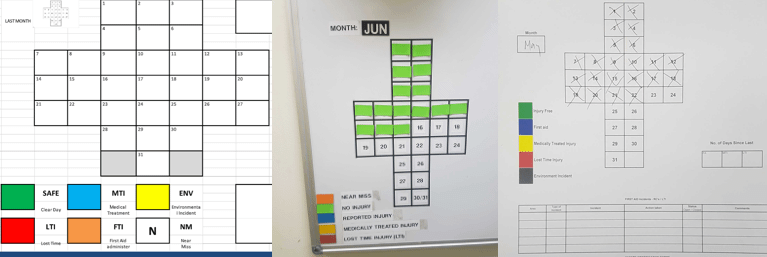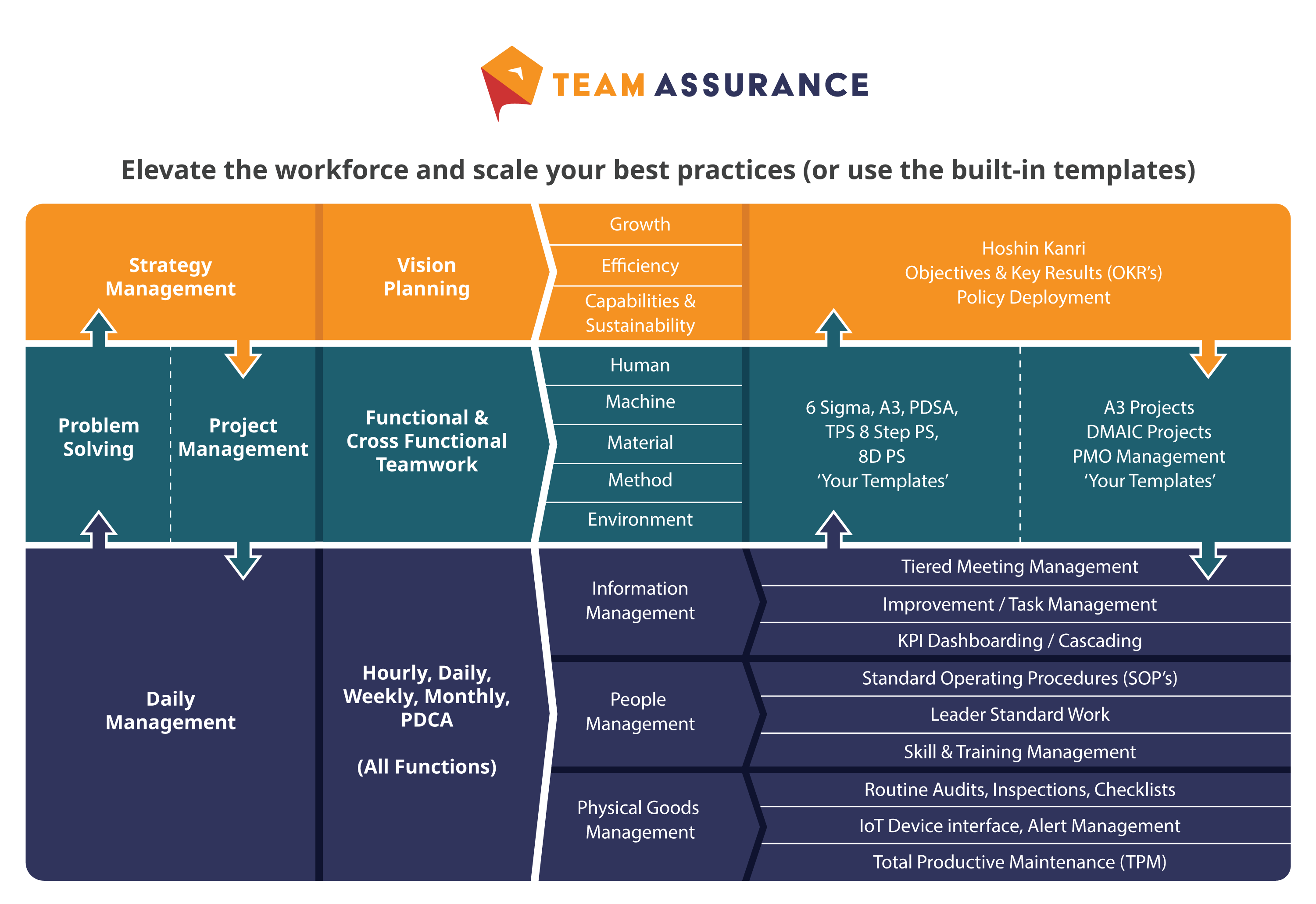We want everyone to go home safe each day, but workplace accidents are a reality. This is especially true in Healthcare and Manufacturing, which experience the highest levels of workplace injuries according to statistics from the U.S. Department of Labor. That’s why safety needs to be a top priority for everyone, with constant communication and action. Only then will safety performance improvements be sustained.
Communicate Safety indicators
Tracking the lead and lag indicators and taking action is not enough. Best practice is to use visual controls for both lag and lead safety indicators. This demonstrates – to everyone – the ongoing effort to prevent injuries. That will encourage more people to participate in activities that prevent injury, and there will be a compounding return on safety performance.
Safety lag indicators
Unsafe acts can lead to injury. At least that’s the basis of the safety triangle: by reducing the number of unsafe acts it may be possible to reduce injury. That’s why it’s important to raise awareness and communicate safety performance at work. One popular communication tool is the Safety Cross (or Safety Calendar). It’s a stark visual representation of the injuries at a facility, measured each day over a month. Often it is located in a tiered meeting area or in a hallway outside the bathrooms. There’s good reason for these locations. They’re high traffic areas where it will get maximum exposure to the workforce that are most at risk.
But is it an effective visual device for safety incident prevention? Most of the time the cross is green (hopefully!). This means “no injury” for that day. If it’s not changing, do people take notice? The Safety Cross will get more attention when the information changes, such as when a square is another color. We appreciate the intended safety message of the cross only after someone has been hurt.

I love the simplicity of it though. It’s universal – I see a Safety Cross at nearly every site I go to. There might be slight variations – an “S” instead of the cross. But it’s still recognizable and easy to understand.
Investigation and improvement
If you are only communicating the injuries then safety will not be perceived as a top priority within the company. What about the root cause analysis and continuous improvement activities associated to the injuries? These will help prevent a recurrence. No doubt these are taking place, however it’s important to show that. The problem I see is the problem-solving and improvement activities are not always made visible. These activities might be pushed to a system that only a few people can access. If they’re not displayed next to the safety cross, people aren’t aware that this follow-up is happening. If they are listed with the safety cross, it’s usually on paper in one area of the site. It’s great that this follow-up is happening, but the frontline aren’t aware of this when it’s not accessible or visible.
Safety lead indicators
While there is general agreement about what the primary safety lag indicator is (someone was hurt or was nearly hurt), there’s no primary lead indicator. That’s because there are many different ways to look at preventing a safety incident.
- Behavior observations (positive and corrective)
- Department safety meetings and Toolbox talks
- Gemba walks
- Risk and Hazard identifications
- Safety campaigns
- Posters and signs
- Safety Checklists and follow-up actions
- Training programs
- Preventive-maintenance
You’ve probably got a dozen more. A healthy mix of these activities will make an impact in preventing injury.
Communicating Lead Indicators
Lead indicator data doesn’t easily map to a monthly visualisation in the way that the Safety Cross does. Each lead indicator can be charted over time in a classic X by Y axis chart. But this looks the same as every other X by Y chart, and it’s not as immediate as the Safety Cross. This dilutes the message and that can impact safety performance. Everyone at the site should know that these activities are occurring. By demonstrating the ongoing effort, people’s behaviour will change accordingly (remember that safety triangle?) and keep everyone safe.
Whatever you use as lead safety indicators, ensure everyone is aware that these measures and activities are tracked. This is an important step in communicating the importance of Safety, influencing a change in behavior and ultimately impacting safety performance.
Raising the bar on Safety
TeamAssurance has already helped to significantly improve the safety culture in many workplaces. The results and numbers we’ve seen are simply outstanding (more on that in the coming weeks). We believe that there’s an opportunity to further impact Safety performance. That’s through a simple, consistent and interactive approach to communicating safety indicators.
We can only build the best solution by focussing on the people that experience this everyday. That’s you! If you’re willing to participate in the research and provide feedback on designs then contact our Head of Product.
A whole C.I. Framework, Not Just a Locally Optimised ‘Island’
For any process to not only be sustained, but to thrive, it must be supported by adjacent processes and systems. So when implementing Lean consider how the various tools interconnect – and ensure you don’t optimise or develop them in isolation. Tools like Leader Standard Work, standardised problem solving techniques, and a Tiered Daily Management system should work together to handle the full PDCA loop.
The schematic below of the TeamAssurance platform below shows how we designed an interconnected platform that avoids disconnected ‘Point Solutions’ (digital or analog) that do not help, and or even act as barriers, to achieving an optimised CI framework.

Want to explore the opportunities offered by digital-aids to Lean tools? If you’re a Business in need, or a Consultant with clients in need, contact us for a demonstration of the TeamAssurance platform today.
TeamAssurance is a digital Operational Excellence platform that helps teams build a safety culture. Contact us today to start improving your safety performance.




